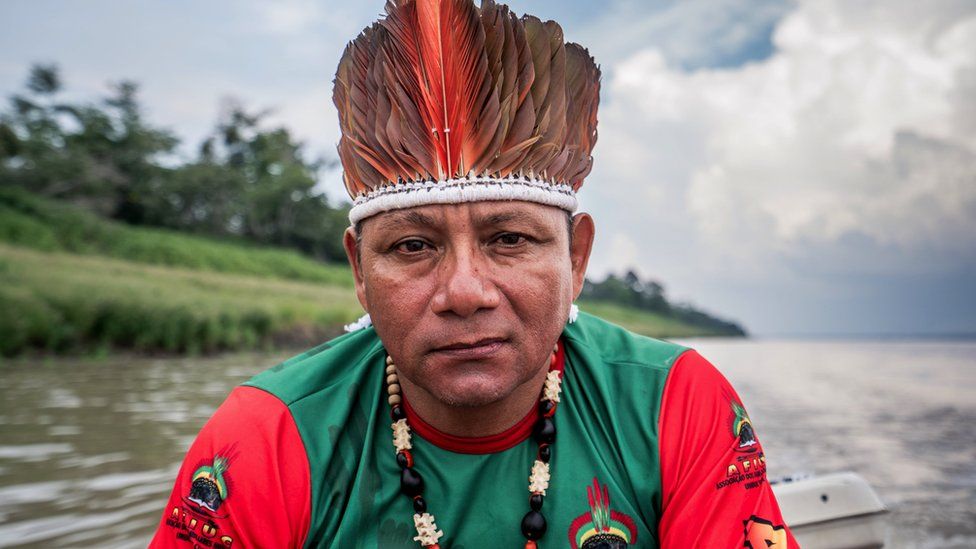-

-
-
Loading

Loading

The Amazon rainforest recently experienced its worst drought on record, leading to severe consequences for the environment and local communities. Villages became inaccessible by river, wildfires spread, and numerous wildlife species perished. Experts are concerned that these events are indicative of a critical point of no return for the world's largest forest. Oliveira Tikuna, while attempting to reach his village in a small metal canoe designed for navigating narrow creeks, begins to doubt the feasibility of his journey. Bom Jesus de Igapo Grande, a community of 40 families located deep within the forest, has been greatly affected by the unprecedented drought. The absence of water has made basic necessities such as showering impossible, and crops like bananas, cassava, chestnuts, and acai have spoiled due to delayed transportation to the city. Recognizing the potential danger posed by the distance from a hospital, Oliveira's father urged elderly and ill individuals to relocate closer to town. Oliveira seeks to show the extent of the situation and warns that the journey will be long. However, even he is amazed when they enter the narrow creek leading to his village. In certain areas, the creek is reduced to a mere trickle, barely one meter wide. Eventually, their boat becomes lodged in the dried riverbed, forcing them to disembark and proceed on foot. Oliveira, noting that further drying would completely isolate his family in the village, expresses concern about the perilous lakebed they would need to cross, inhabited by snakes and alligators. Normally, the rainy season in the Amazon begins in October, but this year it remained dry and hot until late November. This prolonged dryness and heat are attributed to the cyclical El Niño weather pattern, which has been intensified by climate change. El Niño causes warming of the Pacific Ocean, leading to increased heated air over the Americas. Furthermore, abnormally warm water in the North Atlantic has enveloped the Amazon in hot and dry air. Flávia Costa, a plant ecologist at the National Institute for Amazonian Research who has spent 26 years studying and living in the rainforest, expresses her concern over the alarming frequency and intensity of recent droughts. While the long-term damage caused by the latest drought remains uncertain, Costa's team has observed signs of plant death. Previous dry seasons have provided some insight into the potential devastation, with estimates suggesting that the 2015 "Godzilla drought" killed 2.5 billion trees and plants in a small region of the forest, despite being less severe than the current drought. Dr. Costa emphasizes that the Amazon's function as a carbon sink has been interrupted during past droughts, and a similar impact is anticipated now. As the Amazon stores about 150 billion tonnes of carbon and is home to tremendous biodiversity, the fear of reaching a tipping point, where the forest transforms into a savannah, is prevalent among many scientists. Currently, around 17% of the Amazon has been deforested, and the global temperature is 1.1C to 1.2C above pre-industrial levels. Brazilian climatologist Carlos Nobre posited a theory in 2018, suggesting that the tipping point would be reached if the Amazon experiences 25% deforestation and the global temperature rises between 2C and 2.5C above pre-industrial levels. Dr. Nobre expresses heightened concern about the situation, questioning the likelihood of greenhouse gas reductions meeting the targets outlined in international agreements. Should the global temperature exceed 2.5C, the implications for the Amazon would be disastrous. However, Dr. Nobre finds solace in the fact that deforestation has declined across all Amazonian countries this year, and all are committed to reducing it to zero by 2030. While not all scientists agree with Dr. Nobre's theory that the forest will be radically transformed, evidence of degradation is apparent throughout the Amazon. The widespread burning of land for agricultural purposes, typically conducted in already degraded regions of the forest, has been exacerbated this year. More fires have been reported in untouched or primary forest areas. Additionally, alarming signs of ecosystem struggles are emerging, such as the discovery of hundreds of dead dolphins in two Amazonian lakes. The high water temperatures, reaching 40.9C, were likely the cause of their demise. Dr. Miriam Marmontel from the Mamirauá Institute for Sustainable Development describes the devastation and the shocking speed of climate change in the Amazon. She believes that these animals serve as sentinels, experiencing the impacts first before they affect humans. For Oliveira, this year's drought has served as a wake-up call. He acknowledges humanity's role in causing this ecological crisis and emphasizes the need to take immediate action to protect and preserve the Amazon.